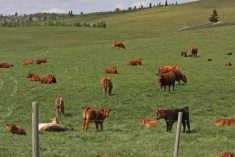Sunflowers promote ice cream
GRISWOLD, Conn. — Growing sunflowers for fundraising has spinoffs by bringing crowds to the Buttonwood Farm’s ice cream business.
“It creates a lot of traffic,” said Duane Button, who plants 14 acres of sunflowers each year at his cattle farm at Griswold, Conn.
The mature flowers are cut by hand and made into $5 bouquets by volunteers during a nine-day Make-A-Wish event each July at the farm.
The family also offers hay and cow train rides, with all proceeds donated to the charity that grants wishes to terminally ill children.
Read Also

Know what costs are involved in keeping crops in the bin
When you’re looking at full bins and rising calf prices, the human reflex is to hold on and hope for more. That’s not a plan. It’s a bet. Storage has a price tag.
“It’s a lot of work but it’s very rewarding,” said Button, a former dairy farmer who now has a beef herd.
Buttonwood Farm has received so much multi-media attention and social media exposure for the event that it no longer needs to buy radio advertising for its ice cream shop.
The event has raised $1.2 million since it was first staged in 2004.
On-farm venture
MYSTIC, Conn. — Allyson Angelini runs a meal-based community-supported agriculture program that allows her to derive income while farming with her children and feeding her neighbours in the Ledyard, Connecticut, region.
Speaking at the North American Farmers’ Direct Marketing Association conference in Mystic, Conn., Feb. 7, she said her Full Heart farm offers its 75 family members pork or chicken and up to four different vegetables.
She expands her weekly offerings as needed by buying from other growers with similar holistic farming practices.
“I teach people to cook from the ground up rather than from a recipe back down,” said Angelini, who once ran a cooking school.
“I want to guide people based on what’s on the farm.”
She provides recipes and maintains a website and newsletter, which shares daily events on the farm where she lives with her husband and two young children.
In addition to interacting with customers at pickup, she also hosts a potluck with members at the end of the growing season.
“That’s what makes people feel connected and invested in your farm,” sad Angelini, whose members also share photos of what they’ve made from the ingredients.
“They’ve become creative cooks as a result,” she said.
Now in its sixth year of operation, the farm commands about $25 weekly up front and Angelini strives for 50 percent profitability.
“That gives me the money I need, an idea of who I am feeding so I plant accordingly. It connects me to my consumer,” she said.
“I’m not wasting my time growing things I might not be able to sell.”














